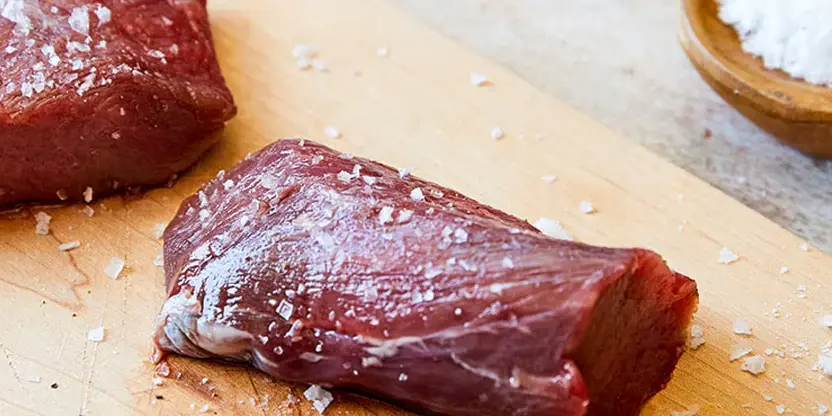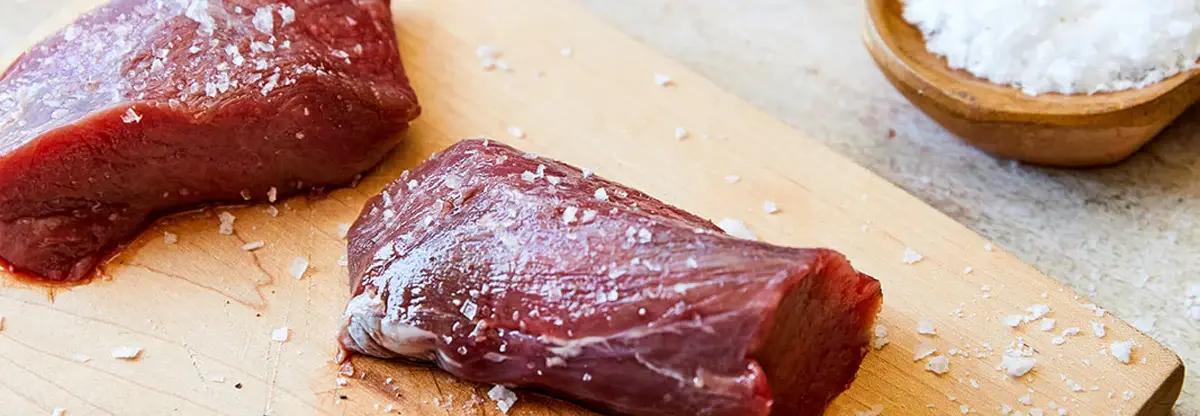
Flavoring Techniques
TIPS FOR SEASONING VENISON
While Axis venison is naturally delicious, these techniques will guarantee a crowd-pleasing meal.
DRY SALT BRINE
We all know that salt is an essential ingredient in cooking, but did you know that you can actually use salt to help keep your meat juicy and flavorful? This process is known as Dry Salt Brining, a process that can have a significant impact on the flavor, juiciness, and crust of your steak. Here's how it works:
- First, salt dissolves on the surface of the meat enhancing flavor by penetrating into the muscle fibers and seasoning your meat from the inside out.
- Second, dry brining helps to keep the meat juicier on the inside as the salt breaks down the muscle proteins, tenderizing the meat and locking in the moisture.
- Finally, dry brining helps to create a delicious crust on the outside of your steak. Because the outside of the steak is dry after the brining process, it will char and form an irresistible crust.
You'll be amazed at the difference it makes! It is a simple and effective way to add flavor and moisture to your meat, and it's especially well suited for venison.
Dry Salt Brining in 4 easy steps
- Grab some kosher or sea salt (steering clear of fine salt or table salt). *Optional step would be to add other non-salt-based seasonings like sugar, spices, or herbs to the salt mixture.
- Pat your meat completely dry of excess moisture.
- Coat meat evenly with salt. Use the right ratio of salt to meat - about ½ tsp of salt per 1 lb of meat. Thereʻs no need to add any more salt to your dish after this step.
Place it on a baking rack over a sheet pan and in the refrigerator uncovered for no less than an hour (overnight would be best) - air circulation will allow the salt to absorb and work its magic into the meat.
Try dry salt brining with these cuts:
Rib Rack , Rib Chops, Tenderloin, Leg Medallions, Loin Chop and Butterflied Leg.
MARINATING
If you're looking for a way to add some extra flavor to your meat, marinating is a great option. The key components of a good marinade are acid, oil, and aromatics. Acid helps to break down the fibers in the meat, making it more tender. Oil helps to lock in moisture, keeping the meat from drying out. And aromatics add an extra layer of flavor. Common aromatics include garlic, ginger, and onions. When choosing an acid for your marinade, vinegar or lemon juice are good options. For the oil, you can use olive oil or sesame oil. Smaller, tender cuts only need to marinate for 30 minutes, but no longer than 12 hours. Larger, tougher cuts should marinate for 2 hours, but no longer than 24 hours.
One thing to keep in mind is that a marinade will not tenderize the silverskin. Make sure to remove this before marinating, as it will also block the penetration of the marinade.
When marinating your meat, you'll want to use a sealable bag or non-reactive container (glass, stainless steel, ceramic, plastic). Aluminum can react with acidic ingredients and produce off flavors. If available, you can save time by using a vacuum sealing device.
If you're preparing meat for stir fry or tacos, slice it into strips and marinate the slices before cooking. When you're ready to cook, use a paper towel, and make sure to pat the meat dry- wet meat will steam instead of brown when it hits the pan, which could lead to overcooking.
DRY RUB
If you're short on time but still want to add some flavor to your steak, there's a quick and easy way to do it. Just mix together a savory blend of salt, spices, and herbs, and massage it into the steak right before cooking. Or if you want to really let the flavors penetrate the meat, leave it to marinate overnight in the refrigerator. Either way, you'll end up with a delicious and tender steak that's full of flavor.
This simple blend of seasonings goes perfectly with our Tenderloin, Strip Loin, Leg Medallions, Loin Chops, Butterflied Leg, Ground, Barnsley, and Shoulder Blade Chop.
SEARING ON ALL SIDES
Searing meat is essential to building texture and adding an extra layer of flavor. Here are a few simple steps to help you get it right:
First, remove excess moisture from the meat by patting it dry with a paper towel- this will remove surface moisture to avoid steaming instead of browning.
Salt the meat an hour before or more (using the Dry Salt Brine Method), or directly before searing, and not in between.
For best results, use a cast-iron or other thick, heavy pan that holds heat well and doesn't crowd the meat.
Ensure that the meat has uninterrupted contact with the pan.
Follow these steps and you'll be well on your way to perfect sear every time.
BUTTER- BASTING
If you're looking for a way to infuse more flavor into your venison steak while keeping it juicy, butter basting is a technique worth trying. In the last few minutes of searing your steak, add a few tablespoons of butter, a couple of cloves of garlic, and fresh herbs like rosemary and thyme. Carefully tilt the pan and continuously spoon the melted butter over the steak until it has reached the desired doneness. The butter will help to create a barrier against the heat, preventing the venison from drying out and ensuring that it remains flavorful and juicy. So next time you're cooking a venison steak, don't forget to give it a little butter-basting love!
COOKING FAT/OILS
Any seasoned chef knows that the key to a good dish is finding the right balance of flavors. This is especially true when it comes to venison, which can be easily overcooked and dry. The key is to add a fat source that will help to moisten the meat and prevent it from drying out. Animal fats like lard or tallow, grass-fed butter, ghee butter, olive oil, and avocado oil all work well for this purpose. These fats can also help to enhance the flavor of the venison.
